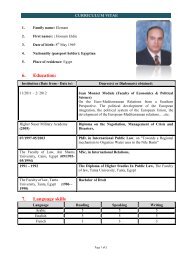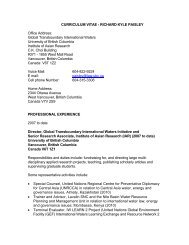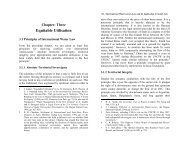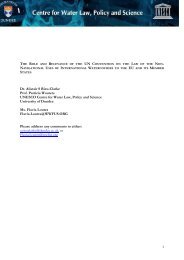Upreti, Trilochan, International Watercourses Law and Its Application ...
Upreti, Trilochan, International Watercourses Law and Its Application ...
Upreti, Trilochan, International Watercourses Law and Its Application ...
Create successful ePaper yourself
Turn your PDF publications into a flip-book with our unique Google optimized e-Paper software.
Equitable Utilisation / 155 156 / <strong>International</strong> <strong>Watercourses</strong> <strong>Law</strong> <strong>and</strong> <strong>Its</strong> <strong>Application</strong> in South Asiaheart of the negotiation process. That phrase appears in each(UNCED) document. The main achievement of the entireprocess is the victory of the principle of equity in majornegotiations between the rich <strong>and</strong> poor nations. Weiss hasrightly observed that"the dominant issue in international environmental lawfor the 1990s is likely to be the one of equity. … whopays whom, how much to clean up the environment orto develop in an environmentally sustainable way". 158There were altogether five texts at the Rio Conference in 1992,of which two (Framework Convention on Climate Change,United Nations Convention on Biological Diversity) are legallybinding. It is notable that all the documents refer to the term'equity'. 159 It is apparent that the international community reliedheavily on the word ‘equity’ in all its meanings, <strong>and</strong> it wastaken as an umbrella concept to effectively pave the way foragreements in the area of providing finance <strong>and</strong> technology tothe South from the North within a comprehensive <strong>and</strong> globalframework of recognition <strong>and</strong> commitment to completedevelopment work in a sustainable manner. Moreover, recentenvironmental treaties have relied heavily on the element ofequity. For example, Articles 3 (1), 4 (2) a <strong>and</strong> 11 (2) of theframework Climate Change Convention, 1992, 160 containsimilar references to equity in securing the contribution of158 28 ILM (1989), p. 1362: introductory note.159 P. W. Birnie <strong>and</strong> A. Boyle, Basic documents on <strong>International</strong> <strong>Law</strong> <strong>and</strong>the Environment, Oxford: Clarendon Press, 1995, pp. 395-405 & 252-274. The Rio Declaration talks of a new <strong>and</strong> equitable partnership, <strong>and</strong>the right to development having to be fulfilled so as to equitably meetthe development <strong>and</strong> environmental needs of present <strong>and</strong> futuregenerations: principle 3 Rio Declaration. Agenda 21 highlights the factthat the development of a new global partnership was ‘inspired by theneed to achieve a more equitable world economy’ paragraph2.1,Agenda 21. The Forest Principles states that benefits should beshared by all states. (Principle1(b)).160 Ibid.developed state parties to reduce green house gas emissions <strong>and</strong>in the governance of the financial mechanism. Similarly,Articles, 8 (j), 15 (7) of the United Nations Convention onBiological Diversity, 161 stipulate the use of the term ‘fair <strong>and</strong>equitable sharing of benefits’ arising from the use of geneticmaterial between the state permitting the research <strong>and</strong> the statefrom which the material originates. These benefits include theresults of subsequent research <strong>and</strong> development, 'commercial<strong>and</strong> other utilisation of genetic resources' <strong>and</strong> the results <strong>and</strong>benefits arising from bio-technologies. Even though there was abroader consensus for achieving equity <strong>and</strong> equitable results,nothing substantive appears to have yet materialised in terms ofaction on the ground. With regard to the meaning of equity inthe Convention, S<strong>and</strong>s has described the actual situationprevailing over the period:“Little consideration was given … to what the conceptmeans or to its consequences when applied to aparticular set of facts. Indeed, the way it wassometimes referred to suggest that some of its mainproponents had little underst<strong>and</strong>ing of its prior use ininternational law.” 162In my view, the meanings of equity <strong>and</strong> equitable utilisationhave been tested on numerous occasions in several spheres.Hence, UNCED does not need to have its own definition. Onthe lack of any precise definition of equity <strong>and</strong> equitableutilisation, French has argued that 163 there are four interrelatedreasons as to why the international community was so eager touse a term that had so far received little usage in internationalenvironmental law. Firstly, the text agreed that UNCED wasnot simply concerned with the issue of environmentalprotection, but rather, the much broader topic of sustainable161 Ibid.162 P. S<strong>and</strong>s, "<strong>International</strong> <strong>Law</strong> in the field of Sustainable Development"(1994) 65 BYIL, p. 340.163 Supra note 67, pp. 10475-77.












